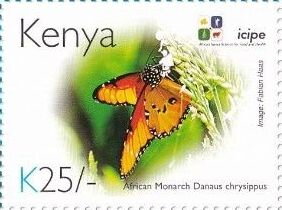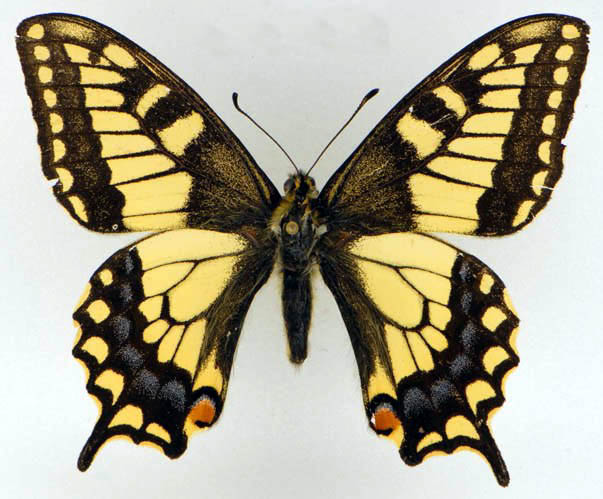Stamp: African Monarch (Danaus chrysippus) (Kenya 2011)
African Monarch (Danaus chrysippus) (Kenya 2011)
16 November (Kenya ) within release ICIPE - Nairobi (2011) goes into circulation Stamp African Monarch (Danaus chrysippus) face value 25 Kenyan shilling
| Stamp African Monarch (Danaus chrysippus) in catalogues | |
|---|---|
| Michel: | Mi: KE 851 |
| Stamp Number: | Sn: KE 853a |
Stamp is square format.
Also in the issue ICIPE - Nairobi (2011):
- Mini Sheet - 40th Anniversary of ICIPE - Nairobi face value 25*25;
- Mini Sheet - 40th Anniversary of ICIPE - Nairobi face value 25*65;
- Mini Sheet - 40th Anniversary of ICIPE - Nairobi face value 25*75;
- Mini Sheet - 40th Anniversary of ICIPE - Nairobi face value 25*95;
- Stamp - African Migrant (Catopsilia florella) face value 25;
- Stamp - African Monarch (Danaus chrysippus) face value 25;
- Stamp - Alucitidae sp. face value 25;
- Stamp - Ant-shape Rove Beetle (Paederus sp.) face value 65;
- Stamp - Anthozela sp. face value 25;
- Stamp - Bactrocera invadens face value 95;
- Stamp - Bactrocera invadens face value 95;
- Stamp - Bactrocera munroi face value 95;
- Stamp - Blister Beetle (Mylabis tristigma) face value 65;
- Stamp - Bombyliidae face value 75;
- Stamp - Braconid Wasp face value 75;
- Stamp - Bush Cricket (Hetrodinae sp.) face value 65;
- Stamp - Bush Locust (Zonocerus variegatus) face value 65;
- Stamp - Carpophthoromyia dimidiata face value 95;
- Stamp - Celidodacus obnubilus face value 95;
- Stamp - Ceratitis caetrata face value 95;
- Stamp - Ceratitis capitata face value 95;
- Stamp - Ceratitis copelandi face value 95;
- Stamp - Ceratitis cosyra face value 95;
- Stamp - Ceratitis cuthbertsoni face value 95;
- Stamp - Ceratitis rosa face value 95;
- Stamp - Ceratitis stictica face value 95;
- Stamp - Ceratitis whartoni face value 95;
- Stamp - Cicada face value 75;
- Stamp - Cockroach (Cartoblatta sp.) face value 65;
- Stamp - Cocoa Mosquito Bug (Helopeltis schoutedeni) face value 65;
- Stamp - Conradtina acroleuca face value 95;
- Stamp - Craspedoxantha sp. face value 95;
- Stamp - Cryptophlebia semilunana face value 25;
- Stamp - Dacus apostata face value 95;
- Stamp - Dacus frontalis face value 95;
- Stamp - Dacus sphaeristicus face value 95;
- Stamp - Dacus telfairae face value 95;
- Stamp - Danaid Eggfly (Hypolimnas misippus) face value 25;
- Stamp - Darkling Beetle (Tenebrionidae) face value 65;
- Stamp - Desert Locust (Schistocerca gregaria) face value 75;
- Stamp - Dictyopharidae face value 75;
- Stamp - Dragonfly (Trithemis sp.) face value 75;
- Stamp - Eggplant Fruit Borer (Leucinodes orbonalis) face value 25;
- Stamp - Eucosmini sp. face value 25;
- Stamp - Eucosmini sp. face value 25;
- Stamp - Eupithecia festiva face value 25;
- Stamp - False Dotted Border (Belenois thysa) face value 25;
- Stamp - Field Form Stag Beetle (Homoderus mellyi) face value 65;
- Stamp - Fig Wasp face value 75;
- Stamp - Fig Wasp, in Flight face value 75;
- Stamp - Gelechioidea sp. face value 25;
- Stamp - Ground Beetle (Cypholoba perspicillaris) face value 65;
- Stamp - Hodebertia testalis face value 25;
- Stamp - Jewel Beetle (Lampetis sp.) face value 65;
- Stamp - Lantern Fly (Pyrops turritus) face value 65;
- Stamp - Large Hive Beetle (Oplostomus haroldi) face value 65;
- Stamp - Leaf Beetle (Nosognatha ruficollis) face value 65;
- Stamp - Locust face value 75;
- Stamp - Longhorn Beetle (Ceroctis sp.) face value 65;
- Stamp - Meadow White (Pontia helice) face value 25;
- Stamp - Megastigmus sp. n. face value 75;
- Stamp - Milkweed Bug (Coreidae) face value 65;
- Stamp - Mosquito Bug (Helopeltis schoutedeni) face value 75;
- Stamp - Munromyia whartoni face value 95;
- Stamp - Net-winged Beetle (Lycidae) face value 65;
- Stamp - Nymphalidae face value 25;
- Stamp - Paper Wasp (Polistes sp.) face value 75;
- Stamp - Paraccra mimesa face value 25;
- Stamp - Parasitoid Wasp (Leucospidae) face value 65;
- Stamp - Parotis prasinalis face value 25;
- Stamp - Plagiotryptus hippiscus face value 75;
- Stamp - Rain Tree Bug (Ptyelus flavescens) face value 75;
- Stamp - Red Tip (Colotis antevippe) face value 25;
- Stamp - Redhead Fly (Bromophila caffra) face value 75;
- Stamp - Reduviidae face value 75;
- Stamp - Rhiniidae cf. Fainia sp. face value 75;
- Stamp - Rhinoceros Beetle (Oryctes sp.) face value 65;
- Stamp - Robber FLy (Lamyra gulo) and wasp prey face value 75;
- Stamp - Sand Fly (Phlebotomus sp.), feeding face value 75;
- Stamp - Scarab Beetle (Popillia aeneipennis) face value 65;
- Stamp - Silverfish face value 75;
- Stamp - Stalk-eyed Fly (Diopsidae) face value 75;
- Stamp - Stingless Bee face value 75;
- Stamp - Stinkbug (Agnoscelis versicolor) face value 65;
- Stamp - Stinkbug (Bagrada cruciferarum) face value 65;
- Stamp - Sweat Bee (Lipotriches sp.) face value 75;
- Stamp - Taomyia marshalli face value 95;
- Stamp - Terrible Hairy Fly (Mormotomyia hirsuta) face value 65;
- Stamp - Themarictera laticeps face value 95;
- Stamp - Tiger Beetle (Cicindela cancellata) face value 65;
- Stamp - Tortoise Beetle (Chrysomelidae) face value 65;
- Stamp - Tortrix dinota face value 25;
- Stamp - Triple Striped Peacock (Chiasmia subcurvaria) face value 25;
- Stamp - Trirhithrum albomaculatum face value 95;
- Stamp - Trirhithrum coffeae face value 95;
- Stamp - Trirhithrum culcasiae face value 95;
- Stamp - Tsetse Fly (Glossina morsitans), feeding face value 75;
- Stamp - Violet Dropwing (Trithemis annulata) face value 75;
- Stamp - Weevil (Curculionidae) face value 65;
- Stamp - Yellow Pansy (Junonia hierta) face value 25;
- Stamp - Yellow Pansy (Precis hierta) face value 25;
- Stamp - Yponomeuta fumigatus face value 25;
- Stamp - Yponomeuta strigillata face value 25;
- Stamp - Zalaca snelleni face value 25;
Stamp African Monarch (Danaus chrysippus) it reflects the thematic directions:
Animals are multicellular, eukaryotic organisms of the kingdom Animalia (also called Metazoa). All animals are motile, meaning they can move spontaneously and independently, at some point in their lives. Their body plan eventually becomes fixed as they develop, although some undergo a process of metamorphosis later on in their lives. All animals are heterotrophs: they must ingest other organisms or their products for sustenance.
An anniversary is the date on which an event took place or an institution was founded in a previous year, and may also refer to the commemoration or celebration of that event. For example, the first event is the initial occurrence or, if planned, the inaugural of the event. One year later would be the first anniversary of that event. The word was first used for Catholic feasts to commemorate saints. Most countries celebrate national anniversaries, typically called national days. These could be the date of independence of the nation or the adoption of a new constitution or form of government. The important dates in a sitting monarch's reign may also be commemorated, an event often referred to as a "Jubilee".
Lepidoptera or lepidopterans is an order of winged insects which includes butterflies and moths. About 180,000 species of the Lepidoptera have been described, representing 10% of the total described species of living organisms, making it the second largest insect order (behind Coleoptera) with 126 families and 46 superfamilies, and one of the most widespread and widely recognizable insect orders in the world
Insects (from Latin insectum, a calque of Greek ἔντομον [éntomon], "cut into sections") are a class (Insecta) of hexapod invertebrates within the arthropod phylum that have a chitinous exoskeleton, a three-part body (head, thorax and abdomen), three pairs of jointed legs, compound eyes and one pair of antennae. They are the most diverse group of animals on the planet, including more than a million described species and representing more than half of all known living organisms. The number of extant species is estimated at between six and ten million, and potentially represent over 90% of the differing animal life forms on Earth. Insects may be found in nearly all environments, although only a small number of species reside in the oceans, a habitat dominated by another arthropod group, crustaceans. The life cycles of insects vary but most hatch from eggs. Insect growth is constrained by the inelastic exoskeleton and development involves a series of molts. The immature stages can differ from the adults in structure, habit and habitat, and can include a passive pupal stage in those groups that undergo 4-stage metamorphosis (see holometabolism). Insects that undergo 3-stage metamorphosis lack a pupal stage and adults develop through a series of nymphal stages. The higher level relationship of the Hexapoda is unclear. Fossilized insects of enormous size have been found from the Paleozoic Era, including giant dragonflies with wingspans of 55 to 70 cm (22–28 in). The most diverse insect groups appear to have coevolved with flowerin plants.




